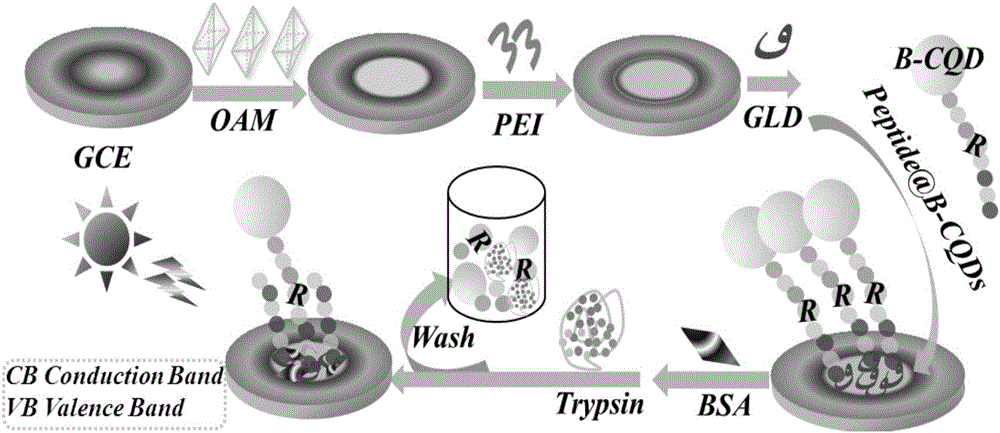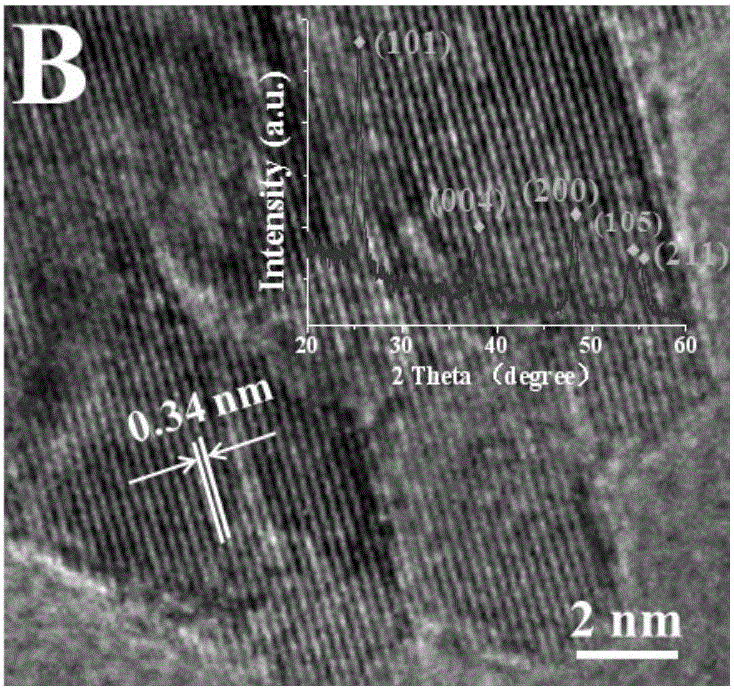TiO2 mesoscopic crystal based trypsin photoelectrochemical detection method
A trypsin and photoelectrochemical technology, applied in the field of trypsin photoelectrochemical detection based on TiO2 mesocrystal, can solve the problems of low photoelectric conversion efficiency and large forbidden band width.
- Summary
- Abstract
- Description
- Claims
- Application Information
AI Technical Summary
Problems solved by technology
Method used
Image
Examples
Embodiment 1
[0040] A kind of TiO-based 2 The preparation method of the photoelectrochemical sensor of mesoscopic crystal (such as figure 1 shown):
[0041] (1) Pretreatment of the glassy carbon electrode: the glassy carbon electrode is first mechanically polished on the suede covered with alumina powder, washed with secondary water to remove the residual powder on the surface, and then moved into an ultrasonic water bath for cleaning until it is cleaned. Wash thoroughly with ethanol, dilute acid and water;
[0042] (2) Add dropwise 4μL of TiO with a concentration of 3mg / ml 2 Put the anatase mesogen suspension on the surface of a clean glassy carbon electrode, dry it under an infrared lamp, and cool it to room temperature;
[0043] (3) Immerse the electrode in 0.5 mg / ml polyacetimide solution for 40 min, and dry it at room temperature;
[0044] (4) Continue to drop 5 μL of glutaraldehyde solution with a concentration of 5.0 wt.% on the surface of the PEI / OAM modified electrode, place i...
Embodiment 2
[0047] Preparation of OAM materials:
[0048] The titanate nanowire precipitation was washed with dilute acetic acid solution, adjusted to pH 3.5, and dried at 60°C for 12 h to obtain the precursor titanate nanowires. Take 400mg of precursor titanate nanowires and disperse them in 70ml of acetic acid solution, react in a 100°C polytetrafluoroethylene autoclave at 200ºC for 48h, wash the obtained product by centrifugation with distilled water and absolute ethanol, and dry at 60ºC for 12 hours and calcined at 400ºC for 30 minutes to remove residual organic matter and obtain TiO2 Octahedral anatase mesoscopic crystals. Electron emission scanning electron microscope (SEM) image of OAM and nitrogen adsorption and desorption process diagram, such as Figure 2A and Figure 2A As shown in the inset, OAM is a symmetrical octahedral particle with a size of 40-100 nm. The nitrogen adsorption and desorption process has a type IV curve with an obvious hysteresis loop isotherm, which prov...
Embodiment 3
[0050] Preparation of B-CODs@petide solution:
[0051] (1) Preparation of B-CODs: 2.1 g of hydroquinone, 10 ml of acetone and 5.16 ml of BBr3 solution were mixed and transferred to a 25 mL polytetrafluoroethylene autoclave and heated at 200°C for 2 H. After the reaction was complete, the autoclave was cooled to room temperature, and the solution was concentrated by rotary evaporation to obtain B-CODs. Transmission electron microscopy (HRTEM) images of B-CODs, such as Figure 2C , indicating that B-CODs also have a lattice structure. The ultraviolet-visible (UV) spectrum and fluorescence (FL) spectrum of B-CODs, such as Figure 2D As shown, it is indicated that B-CODs have high light absorption, and photogenerated electrons and holes are easily recombined, which can effectively improve the sensitivity of PEC biosensors.
[0052] (2) Preparation of B-CODs@petide solution: 10 μL of boron-doped carbon quantum dots with a concentration of 10 mg / ml was dispersed in 50 μl of an AP...
PUM
 Login to View More
Login to View More Abstract
Description
Claims
Application Information
 Login to View More
Login to View More - R&D
- Intellectual Property
- Life Sciences
- Materials
- Tech Scout
- Unparalleled Data Quality
- Higher Quality Content
- 60% Fewer Hallucinations
Browse by: Latest US Patents, China's latest patents, Technical Efficacy Thesaurus, Application Domain, Technology Topic, Popular Technical Reports.
© 2025 PatSnap. All rights reserved.Legal|Privacy policy|Modern Slavery Act Transparency Statement|Sitemap|About US| Contact US: help@patsnap.com



